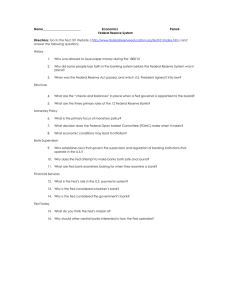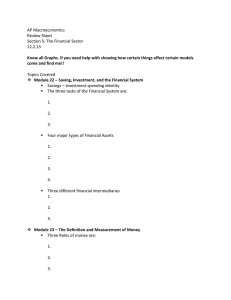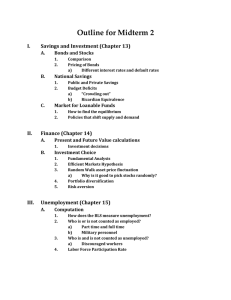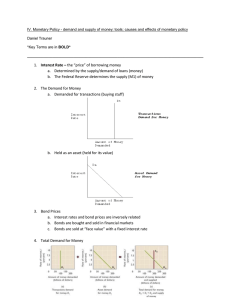Money and Banking ARSC 1432 Macroeconomics Co
advertisement
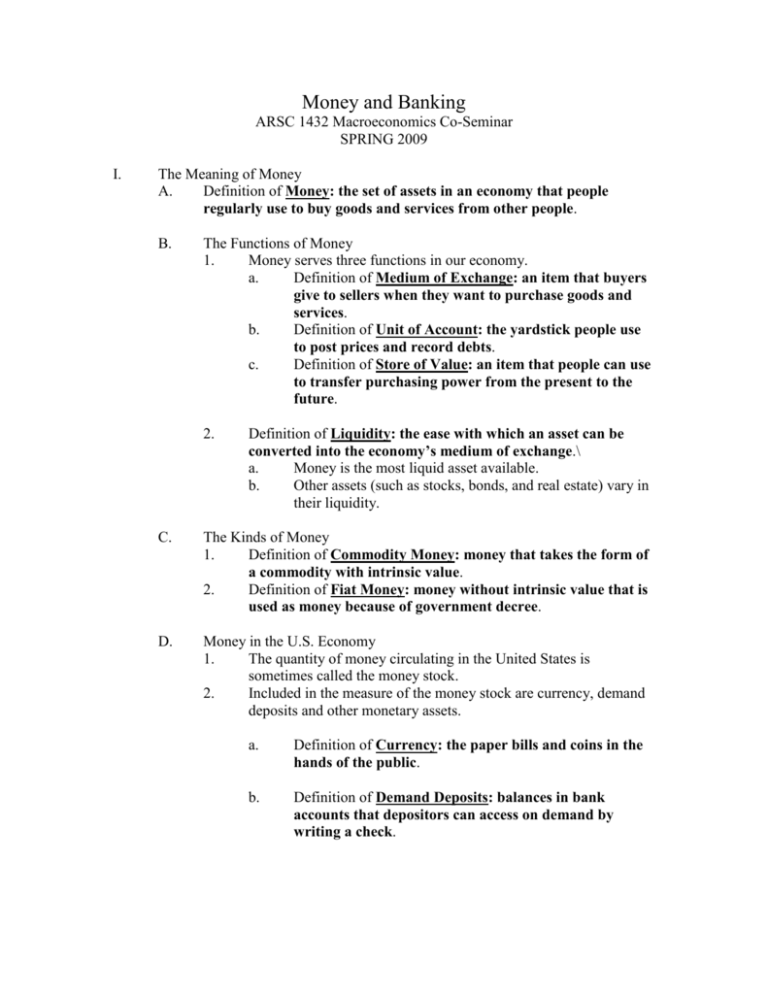
Money and Banking ARSC 1432 Macroeconomics Co-Seminar SPRING 2009 I. The Meaning of Money A. Definition of Money: the set of assets in an economy that people regularly use to buy goods and services from other people. B. The Functions of Money 1. Money serves three functions in our economy. a. Definition of Medium of Exchange: an item that buyers give to sellers when they want to purchase goods and services. b. Definition of Unit of Account: the yardstick people use to post prices and record debts. c. Definition of Store of Value: an item that people can use to transfer purchasing power from the present to the future. 2. Definition of Liquidity: the ease with which an asset can be converted into the economy’s medium of exchange.\ a. Money is the most liquid asset available. b. Other assets (such as stocks, bonds, and real estate) vary in their liquidity. C. The Kinds of Money 1. Definition of Commodity Money: money that takes the form of a commodity with intrinsic value. 2. Definition of Fiat Money: money without intrinsic value that is used as money because of government decree. D. Money in the U.S. Economy 1. The quantity of money circulating in the United States is sometimes called the money stock. 2. Included in the measure of the money stock are currency, demand deposits and other monetary assets. a. Definition of Currency: the paper bills and coins in the hands of the public. b. Definition of Demand Deposits: balances in bank accounts that depositors can access on demand by writing a check. II. The Federal Reserve System A. B. C. D. 2 Definition of Federal Reserve (Fed): the central bank of the United States. Definition of Central Bank: An institution designed to oversee the banking system and regulate the quantity of money in the economy. The Fed’s Organization 1 The Fed was created in 1914 after a series of bank failures. 2. The Fed has a Board of Governors with seven members who serve 14-year terms. a. The Board of Governors has a chairman who is appointed for a four-year term. b. The current chairman is Ben Bernanke 3. The Federal Reserve System is made up of 12 regional Federal Reserve Banks located in major cities around the country. 4. The Fed’s jobs are: a. One job that the Fed does is the regulation of banks to ensure the health of the nation’s banking system. b. The second job of the Fed is to control the quantity of money available in the economy. a. Definition of Money Supply: the quantity of money available in the economy. b. Definition of Monetary Policy: the setting of the money supply by policymakers in the central bank. The Federal Open Market Committee 1. The Federal Open Market Committee (FOMC) consists of the 7 members of the Board of Governors and 5 of the 12 regional Federal Reserve District Banks. 2. The FOMC meets about every six weeks in order to discuss the condition of the economy and consider changes in monetary policy. 3. The primary way in which the Fed increases or decreases the supply of money is through open market operations (which involves the purchase or sale of government bonds). a. If the Fed wants to increase the supply of money, it purchases government bonds from the public. b. If the Fed wants to lower the supply of money, it sells government bonds from its portfolio to the public. Money is then taken out of the hands of the public and the supply of money falls.





